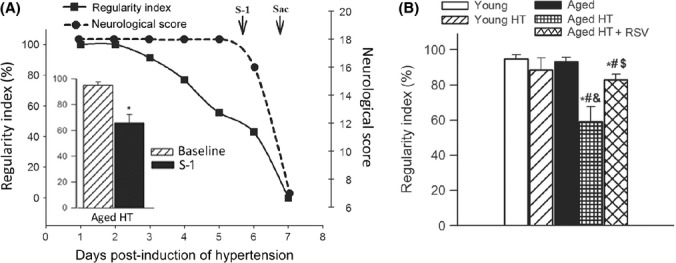Fig 2.

Increased incidence of cerebral microhemorrhages (CMHs) is associated with early gait dysfunction in hypertensive aged mice: prevention by resveratrol treatment. Panel A shows that dysfunction of gait coordination (indicated by changes in the regulatory index) is manifested before the onset of signs of intracerebral hemorrhage detectable by standard neurological examination. Regularity index is a measure of interpaw coordination. In healthy, fully coordinated animals, its value is 100%. Inset: significant decline in the regularity index between the day before induction of hypertension and the day before the onset of clinically detectable hemorrhage (S-1) in hypertensive aged mice. Data are mean ± SEM. *P < 0.05 vs. Day baseline. (n = 20). B: Data from cross-sectional studies. Shown are changes in regularity index induced by treatment with angiotensin II plus L-NAME (HT groups) in young (3 months, n = 20), aged (24 months, n = 20), and resveratrol-treated aged (n = 20) C57BL/6 mice on day 5 postinduction of hypertension. Note that aging exacerbates hypertension-induced decline in the regulatory, which is reversed by resveratrol treatment. Data are mean ± SEM. *P < 0.05 vs. Young, #P < 0.05 vs. aged, &P < 0.05 vs. Young HT, $P < 0.05 vs. Aged HT (n = 20 in each group).
